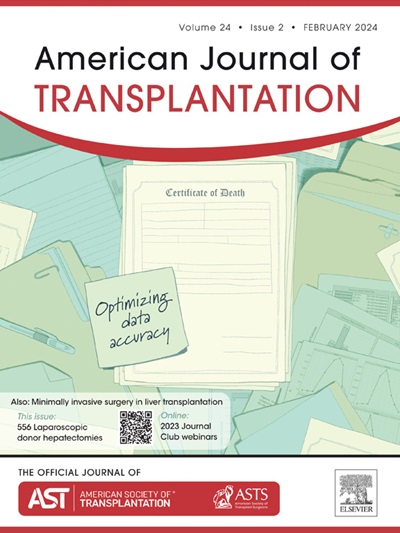利用供体无细胞DNA分数和数量检测心脏移植后急性排斥反应的双阈值算法。
IF 8.2
2区 医学
Q1 SURGERY
引用次数: 0
摘要
供体来源的无细胞DNA (dd-cfDNA)是心脏移植(HTx)后急性排斥反应(AR)的一种有前景的生物标志物。作为总cfDNA的一部分测量的dd-cfDNA可能受到总cfDNA变化的影响,而dd-cfDNA的数量可以减轻这种影响。本研究探讨了结合dd-cfDNA分数(dd-cfDNA%)和供体数量评分(DQS)的双阈值算法(2TA)的性能。187例成人HTx患者同时行心内膜活检,共前瞻性收集808份血浆样本进行dd-cfDNA检测。cfDNA分析采用基于单核苷酸多态性(SNP)的新一代测序工作流程;采用测序reads和SNP基因型测定dd-cfDNA%和DQS。AR组的dd-cfDNA%和DQS均显著高于非AR组(p<10-14)。考虑到超过dd-cfDNA%=0.26%或DQS=18 cp/mL的样品为阳性,2TA检测AR的灵敏度为86.5%,特异性为83.6%,AUC为0.881。与单独使用dd-cfdNA%相比,平均净重分类指数(NRI)提高了16.4% (SD: 4.0%;P =0.015),假阳性率比之前设定的截止值0.15%降低了37.3%。与单独使用dd-cfDNA%相比,在2TA中结合dd-cfDNA分数和数量估计值可以提高HTx受体AR检测的准确性。本文章由计算机程序翻译,如有差异,请以英文原文为准。
A two-threshold algorithm using donor-derived cell-free DNA fraction and quantity to detect acute rejection after heart transplantation
Donor-derived cell-free DNA (dd-cfDNA) is a promising biomarker of acute rejection (AR) after heart transplantation (HTx). dd-cfDNA, measured as a fraction of total cfDNA, can be affected by changes in total cfDNA whereas dd-cfDNA quantity can mitigate this impact. This study investigated the performance of a 2-threshold algorithm (2TA) that combines dd-cfDNA fraction (dd-cfDNA%) and donor-quantity score (DQS). A total of 808 plasma samples were prospectively collected for dd-cfDNA testing from 187 adult HTx patients with contemporaneous endomyocardial biopsies. cfDNA was analyzed by a single nucleotide polymorphism-based next-generation sequencing workflow; dd-cfDNA% and DQS were measured using the sequencing reads and single nucleotide polymorphism genotypes. Both dd-cfDNA% and DQS were significantly higher in AR than in non-AR samples (P < 10−14). Considering samples exceeding either dd-cfDNA% = 0.26% or DQS = 18 copies/mL as positive, the 2TA demonstrated 86.5% sensitivity and 83.6% specificity for AR detection and an area under the curve of 0.881. Compared to dd-cfdNA% alone, performance improved with a mean net reclassification index of 16.4% (standard deviation: 4.0%; P = .015) and a 37.3% reduction in the number of the false positive cases compared to the previously established cutoff of 0.15%. Combining dd-cfDNA fraction and quantity estimate in a 2TA may improve AR detection accuracy in HTx recipients compared with dd-cfDNA% alone.
求助全文
通过发布文献求助,成功后即可免费获取论文全文。
去求助
来源期刊
CiteScore
18.70
自引率
4.50%
发文量
346
审稿时长
26 days
期刊介绍:
The American Journal of Transplantation is a leading journal in the field of transplantation. It serves as a forum for debate and reassessment, an agent of change, and a major platform for promoting understanding, improving results, and advancing science. Published monthly, it provides an essential resource for researchers and clinicians worldwide.
The journal publishes original articles, case reports, invited reviews, letters to the editor, critical reviews, news features, consensus documents, and guidelines over 12 issues a year. It covers all major subject areas in transplantation, including thoracic (heart, lung), abdominal (kidney, liver, pancreas, islets), tissue and stem cell transplantation, organ and tissue donation and preservation, tissue injury, repair, inflammation, and aging, histocompatibility, drugs and pharmacology, graft survival, and prevention of graft dysfunction and failure. It also explores ethical and social issues in the field.

 求助内容:
求助内容: 应助结果提醒方式:
应助结果提醒方式:


